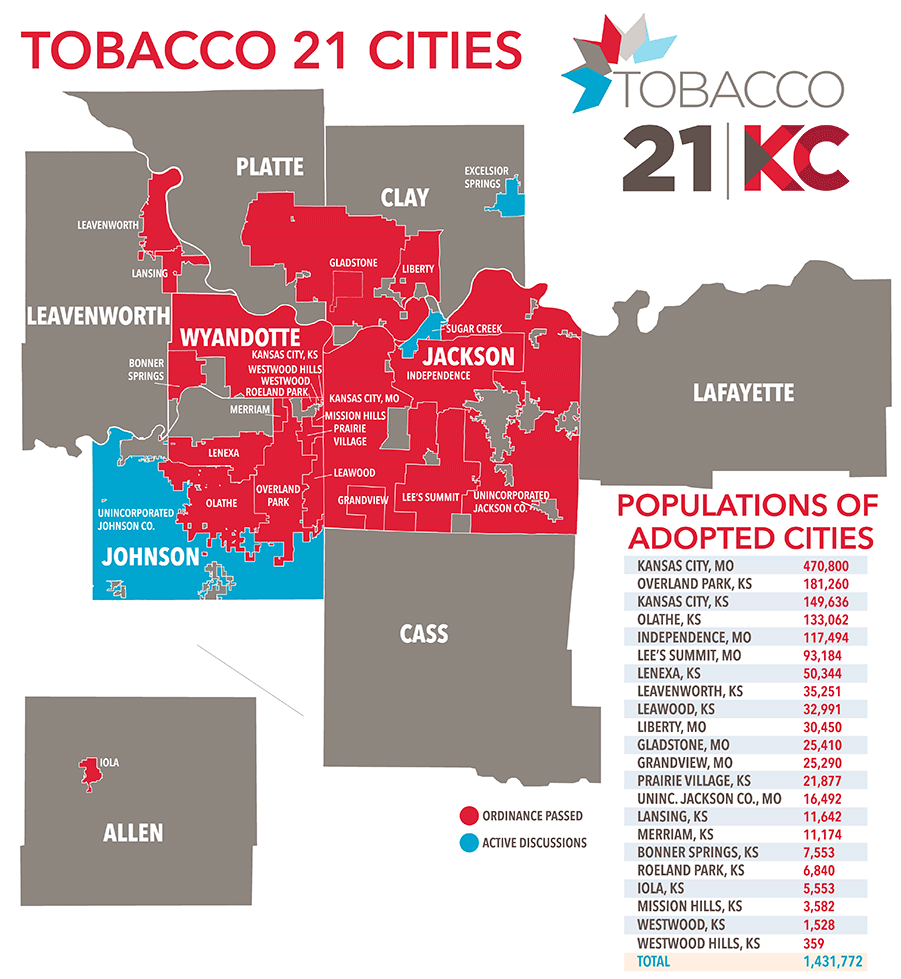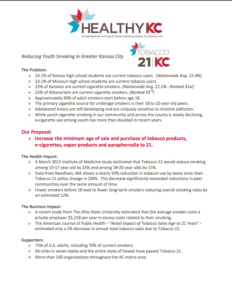Tobacco 21 in Kansas City
 Across the Kansas City metro area, 22 localities have passed ordinances raising the minimum legal sales age for tobacco products to 21. We talked with Scott Hall, Senior Vice President of Civic and Community Initiatives at the Greater Kansas City Chamber of Commerce to learn more about their “Tobacco 21” movement.
Across the Kansas City metro area, 22 localities have passed ordinances raising the minimum legal sales age for tobacco products to 21. We talked with Scott Hall, Senior Vice President of Civic and Community Initiatives at the Greater Kansas City Chamber of Commerce to learn more about their “Tobacco 21” movement.
How did Tobacco 21 get started in the Kansas City area, and who was involved?
About three and a half years ago, the Greater Kansas City Chamber of Commerce started Healthy KC, a health and wellness coalition, in partnership with Blue Cross and Blue Shield of Kansas City and other regional health and wellness leaders. That’s around the time they started thinking about Tobacco 21.
In October 2013, New York City made history by becoming the first major city in the United States to raise the minimum legal sale age for tobacco to 21. Hall said he first heard about Tobacco 21 shortly after that in the spring of 2014 from a doctor at the University of Kansas Medical Center, and he began watching Tobacco 21 policy activity across the country.
In December of 2014, Columbia, MO passed a Tobacco 21 policy, making the policy seem more feasible to pass in the nearby Kansas City area. Hall and others began work to get the Chamber’s Board of Directors to authorize working on Tobacco 21.
Hall noted, “The Greater Kansas City Chamber of Commerce understands that the health of our community is tied to its growth. Tobacco21 is a great way to drive towards community health and regional prosperity.” In August of 2015, the Chamber voted to take it on, officially launching the Tobacco 21|KC effort.
The formation of Healthy KC had facilitated connections among public health organizations, and by the time of the board’s authorizing vote, over 100 other organizations, ranging from big hospital systems to children’s advocacy groups to insurance companies and brokerage firms, as well as small businesses, had signed on to endorse the policy. See full list of endorsements here.
How did you make the case?
When presenting Tobacco 21 as an idea both to endorsing organizations and to city or county decision makers, they first presented the states’ tobacco problem to show why the policy was necessary. Smoking rates in Kansas and Missouri are both above the national average. Missouri has the lowest cigarette excise tax in the country at $0.17 per pack.
 High rates of tobacco use are costly not only to smokers, but to governments and businesses as well. One particularly convincing piece of data the group shared is from research conducted at Ohio State University, which showed that the cost to a private employer for an employee to smoke is an average of $5,816 more per year than the cost of an employee who has never smoked. This calculation takes into account health care costs as well as the costs of absenteeism, lost productivity, and smoke breaks. Hall said that number was, “really persuasive in getting local governments to take action. It really quickly becomes a significant economic impact to their community.”
High rates of tobacco use are costly not only to smokers, but to governments and businesses as well. One particularly convincing piece of data the group shared is from research conducted at Ohio State University, which showed that the cost to a private employer for an employee to smoke is an average of $5,816 more per year than the cost of an employee who has never smoked. This calculation takes into account health care costs as well as the costs of absenteeism, lost productivity, and smoke breaks. Hall said that number was, “really persuasive in getting local governments to take action. It really quickly becomes a significant economic impact to their community.”
In highlighting Tobacco 21 as an evidence-based solution, they walked folks through the example of Needham, Massachusetts. The town enacted its law raising the minimum age to 21 in 2005. Subsequent research and evaluation revealed that in the four years following implementation, smoking rates in Needham decreased by 47%, three times as much as the rates in surrounding towns.
In addition, the Tobacco 21| KC group highlighted findings from a 2015 Institute of Medicine report, which estimated that raising the age to 21 nationally would reduce smoking initiation among youth ages 15-17 by 25% and among youth ages 18-20 by 15%.
While the group has not undertaken a true community education campaign, they have taken the opportunity to present to groups anytime they can, including to city councils and to broader groups that impact local health policy.
See the Tobacco 21 | KC one-pager here.
What was the process for formulating the Tobacco 21 ordinances?
In getting the actual ordinance passed in Kansas City, the group initially provided a sample ordinance from another city that had passed Tobacco 21, but then worked with city attorney to draft the ordinance to make sure it was effective, not overly burdensome, and efficient.
Hall noted that “It really has been such a team effort. There are probably 100 people who have worked on it across the metro area. The KC Chamber would never have been able to do this without the coalition of experts supporting, refining, and enhancing this idea.”
How does Tobacco 21 fit into your broader point-of-sale and/or strategy to prevent youth access to tobacco?
As Hall said, “It’s just one piece of the puzzle. Preventing youth tobacco use takes a multi-faceted approach – this is just one tool in the toolkit.” [space height=”10″]
While cities in the Greater Kansas City metro area have not focused much of point of sale tobacco control policy yet, Hall noted that the focus on Tobacco 21 has brought other tobacco issues to the minds of city council members. A number of cities passed other tobacco policies at the same time as Tobacco 21 passed. For example, Kansas City, MO and Kansas City, KS both passed legislation that included e-cigarettes in their clean air ordinances at the same time as they passed Tobacco 21. Another city passed a tobacco-free parks ordinance at the same time.
Lessons Learned: If you had to start all over, would you do anything different?
Hall said that the most important thing is to think about enforcement in advance. This includes understanding how existing tobacco laws are enforced. For instance, state laws in Kansas and Missouri set the minimum age at 18, so state-funded compliance checks will only enforce the 18-and-over rule. However, groups in the Kansas City area have been able to work closely with county health departments to help with enforcement and secured funding from foundations to help cover costs.
In addition, thinking through the enforcement language of the bill is important. Enforcement of the new Tobacco 21 laws in the greater KS area depends on the jurisdiction. While Hall says all of the T21 laws in the metro include a penalty to the seller, due to existing tobacco control laws, some also include penalties for purchase, though few, if any, contain penalties for possession. Read more about the difference between age of purchase and age of sale.
Hall’s second biggest piece of advice for other municipalities interested in passing their own Tobacco 21 laws is about readiness: “don’t go too far too fast.”
While the Tobacco 21 ordinance passed in 22 cities in the Kansas City area, it failed in 3 or 4 others. Hall notes that pushing the policy in communities that are not ready for it does not always turn out well. He says it’s better to hold back than to lose. His advice instead is, “If you can’t win the city, find neighboring jurisdictions and try and win there – let the momentum bleed from one city to the next.”
Hall says a key component of readiness is having enough support from city council members. Even if community members are supportive, council members may not be, and it’s important to find out where they stand.
Learn more about the group’s lessons learned in the Health Affairs blog written by Hall and his colleague Jessica Hembree, “Raising the Age of Purchase for Tobacco Products: Lessons Learned From Tobacco21”
What’s next?
Tobacco21 will continue to expand in the greater Kansas City metro area, which crosses two states and includes nearly 100 municipalities. There are a number of local communities in the area that are working on ordinances in the first half of 2017. They are also exploring other tobacco prevention and cessation interventions, including expanding clean air laws and raising tobacco taxes.
Learn more about Tobacco 21 policies.
– Read more Stories from the Field –


